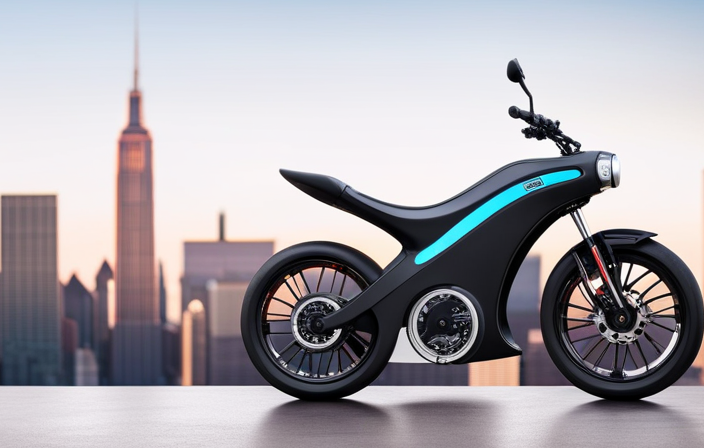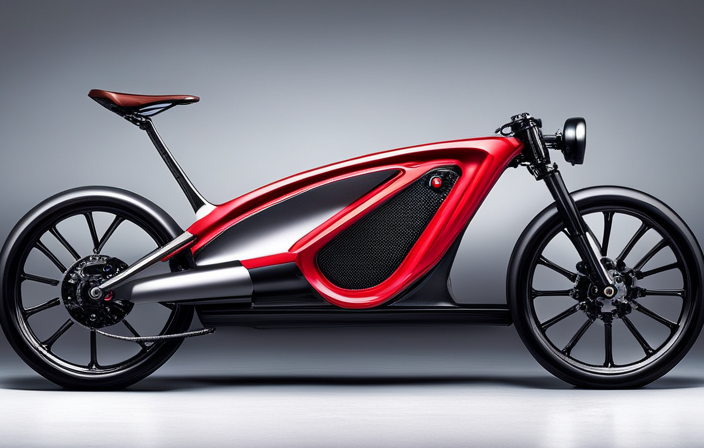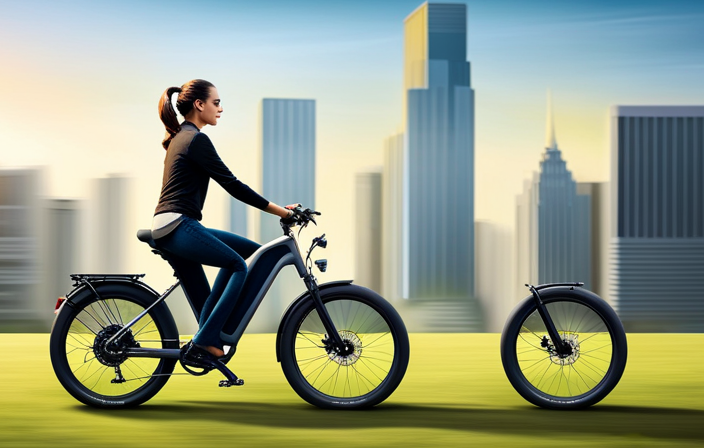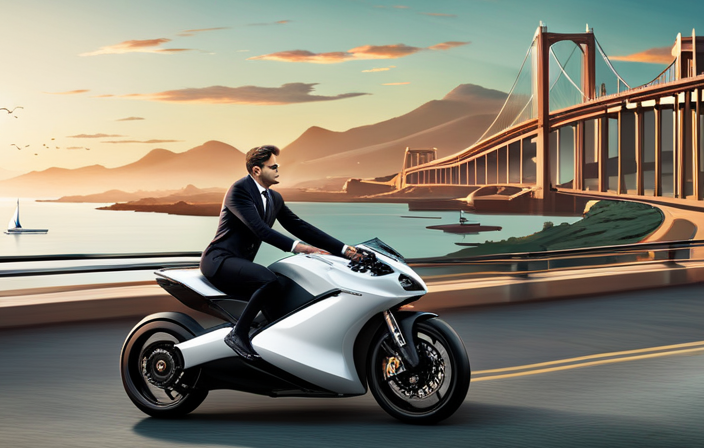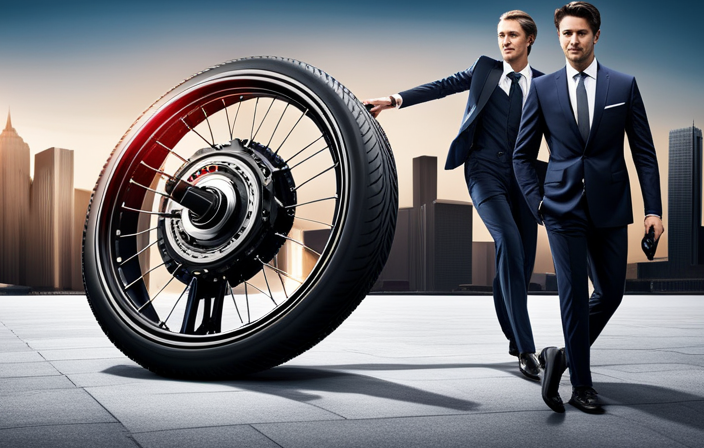As an avid cyclist, I have always been intrigued by the concept of electric bikes. The idea that a simple pedal-powered bicycle can be transformed into a powerful and efficient mode of transportation is truly fascinating.
In this article, we will delve into the world of electric bikes, exploring their definition, components, benefits, and regulations.
Whether you are a commuting enthusiast or simply curious about this innovative technology, join me as we uncover the truth behind electric bikes and their potential to revolutionize the way we travel.
Key Takeaways
- Electric bikes are bicycles equipped with an electric motor for assistance.
- They provide extra power when pedaling and can be charged by plugging into a regular power outlet.
- Electric bikes offer a more environmentally sustainable transportation option, producing zero emissions.
- They provide a convenient and practical choice for urban commuters and contribute to improved mental well-being.
Definition and Components of Electric Bikes
If you’re not familiar with electric bikes, they are bicycles that are equipped with an electric motor to assist with pedaling. Electric bikes, also known as e-bikes, have become increasingly popular in recent years due to their ability to provide an extra boost of power when riding.
There are different types of motors used in electric bikes, such as hub motors and mid-drive motors. Hub motors are located in either the front or rear wheel and provide direct power, while mid-drive motors are located near the pedals and offer a more balanced and natural riding experience.
As for battery charging methods, most electric bikes can be charged by plugging them into a regular power outlet. Some e-bikes also have regenerative braking, which helps to recharge the battery while riding.
Now that we understand the components of electric bikes, let’s delve into how they actually work.
How Electric Bikes Work
To understand the mechanics of electric bicycles, it’s important to know how the motor assists the rider. Electric bikes work by utilizing a motor that provides assistance to the rider’s pedaling. This motor is powered by a rechargeable battery, which is typically located on the frame of the bike.
The motor kicks in when the rider starts pedaling and provides an extra boost, making it easier to ride uphill or travel at higher speeds. Improving battery efficiency is a key focus in electric bike technology, as it allows for longer rides and reduces the need for frequent recharging.
Electric bikes have also had a positive impact on public transportation, as they provide a convenient and eco-friendly alternative for short distance commuting. They can be easily folded and carried on trains or buses, making them a practical choice for urban commuters.
With their numerous benefits for commuting, electric bikes are becoming increasingly popular for those looking for a greener and more efficient way to travel.
Benefits of Electric Bikes for Commuting
One of the major advantages of electric bicycles for commuting is their ability to easily navigate through heavy traffic. With their electric motor assistance, electric bikes allow riders to effortlessly maneuver through congested streets, making commuting in busy urban areas much more efficient and stress-free. This improved ease of navigation not only saves time but also contributes to improved mental well-being, as it reduces the frustration and anxiety often associated with sitting in traffic jams.
Additionally, electric bikes are a more environmentally sustainable transportation option compared to traditional cars or motorcycles. They produce zero emissions, helping to reduce air pollution and combat climate change.
Transitioning into the subsequent section about the health benefits of riding electric bikes, it is important to note that these benefits extend beyond just personal well-being.
Health Benefits of Riding Electric Bikes
Riding electric bikes offers numerous health benefits. One of these benefits is improved cardiovascular health. The act of pedaling helps to strengthen the heart and increase blood circulation, resulting in a healthier cardiovascular system.
Additionally, riding an electric bike provides a low-impact form of exercise. This is easier on the joints compared to high-impact activities like running. Therefore, it is an ideal option for individuals with joint issues or those who are looking for a gentler way to stay active.
Lastly, regular electric bike rides can help increase stamina and endurance over time. This allows riders to go further and longer with each ride.
Overall, riding electric bikes is a great way to improve cardiovascular health, provide low-impact exercise, and increase stamina and endurance.
Improved Cardiovascular Health
You can improve your cardiovascular health by regularly using an electric bike. Electric bikes provide a low-impact form of exercise that helps to increase your heart rate and strengthen your cardiovascular system.
Here are four ways in which riding an electric bike can improve your cardiovascular health:
-
Improved overall fitness: Regularly riding an electric bike can improve your overall fitness level by increasing your stamina and endurance.
-
Reduced risk of chronic diseases: Engaging in regular cardiovascular exercise, such as riding an electric bike, can help reduce the risk of chronic diseases like heart disease, stroke, and diabetes.
-
Increased heart rate: Riding an electric bike can elevate your heart rate, providing a beneficial cardiovascular workout.
-
Strengthened cardiovascular system: The consistent pedaling motion on an electric bike can strengthen your heart and improve blood circulation throughout your body.
By incorporating low-impact exercise like riding an electric bike into your routine, you can further enhance your cardiovascular health.
Low-Impact Exercise
Improved cardiovascular health is not the only benefit of electric bikes. Another advantage is that they provide a low-impact form of exercise. As someone who has experienced joint pain in the past, I can attest to the importance of finding exercises that are gentle on the joints. Electric bikes are a great option because they offer a smooth and controlled ride, reducing strain on the joints.
Additionally, riding an electric bike requires balance, which can help improve coordination and stability. This is especially beneficial for older adults who may be at risk of falls. By incorporating electric bike rides into your routine, you can improve your balance and reduce the risk of joint injuries.
Now, let’s move on to another key benefit of electric bikes: increased stamina and endurance.
Increased Stamina and Endurance
To build up your stamina and endurance, it’s essential to incorporate activities that challenge your cardiovascular system. One great way to achieve this is by using an electric bike.
Electric bikes provide an excellent opportunity to increase your stamina and endurance levels. By pedaling against the resistance of the electric motor, you can gradually push yourself to go faster and farther, thus improving your overall cardiovascular fitness.
As you continue to ride, you’ll notice an increase in your lung capacity, allowing you to take in more oxygen and go for longer rides without feeling fatigued. With increased stamina and endurance, you’ll be able to tackle more challenging terrains and enjoy longer rides with ease.
Now, let’s explore the different types of electric bikes available in the market.
Types of Electric Bikes
There are various types of electric bikes available in the market. When it comes to electric bikes, the type you choose depends on your specific needs and preferences. Here are three popular types of electric bikes: The first type is the commuter e-bike, designed for daily travel with features like pedal assist and long battery life. Mountain e-bikes are another popular choice, built for off-road adventures with powerful motors and durable frames. Lastly, folding e-bikes offer a compact and portable solution for urban riders who need convenience and easy storage. These different types of electric bikes cater to a wide range of riders and purposes.
-
Commuter Electric Bikes: Designed for urban commuting, these bikes are lightweight and have a comfortable riding position. They usually come with a smaller motor and battery, making them ideal for shorter distances.
-
Mountain Electric Bikes: Built for off-road adventures, these bikes have a more powerful motor and larger battery. They feature rugged frames, wider tires, and advanced suspension systems to handle rough terrains with ease.
-
Folding Electric Bikes: Perfect for those with limited storage space, these bikes can be easily folded and stored in small spaces. They usually have a smaller motor and battery, making them suitable for shorter commutes.
Considering the types of batteries and motor power options available, it’s important to choose an electric bike that aligns with your specific needs and preferences.
Transitioning into the subsequent section about ‘considerations for choosing an electric bike,’ it is essential to thoroughly evaluate your requirements and make an informed decision.
Considerations for Choosing an Electric Bike
When considering an electric bike, there are several key points to keep in mind.
First, it’s important to consider the battery range and power, as this will determine how far and how fast you can ride.
Secondly, the frame size and comfort should be considered, as you want to ensure a comfortable and ergonomic riding position.
Lastly, don’t forget to think about additional features and accessories that may enhance your riding experience, such as lights, fenders, and racks.
Battery Range and Power
You can easily increase the battery range and power of your electric bike by choosing a higher capacity battery. A higher capacity battery will provide you with a longer battery life, allowing you to ride for longer distances without needing to recharge. Additionally, a higher capacity battery will also give your electric bike more power, resulting in better motor performance. This means that you will be able to tackle steeper inclines and ride at faster speeds with ease. To help you understand the relationship between battery capacity and range, and battery capacity and power, I have provided a table below:
| Battery Capacity (Ah) | Range (miles) | Power (Watts) |
|---|---|---|
| 10 | 20 | 250 |
| 15 | 30 | 350 |
| 20 | 40 | 450 |
Considering battery range and power is crucial when choosing an electric bike. Now, let’s move on to the next section about frame size and comfort.
Frame Size and Comfort
When it comes to electric bikes, battery range and power are crucial factors to consider. However, another important aspect that shouldn’t be overlooked is frame size and comfort.
The frame size determines the overall fit of the bike, ensuring that you have a comfortable riding experience. Electric bikes are designed with an ergonomic design in mind, allowing for a more natural riding position and reducing strain on your body. Additionally, many electric bikes are equipped with suspension systems, which absorb bumps and vibrations from the road, further enhancing your comfort.
To emphasize the significance of frame size and comfort, consider the following:
1) Proper frame size ensures a comfortable riding position and reduces the risk of injuries.
2) Ergonomic design promotes better posture and reduces fatigue during long rides.
3) Suspension systems provide a smoother and more enjoyable ride, especially on rough terrains.
Now, let’s explore the exciting world of additional features and accessories that electric bikes offer.
Additional Features and Accessories
To enhance your riding experience, electric bikes come with a range of additional features and accessories. These extras not only add convenience but also ensure your safety on the road.
Some electric bikes are equipped with additional safety features such as integrated lights, reflective tires, and horn systems to alert pedestrians and other cyclists. These features help you stay visible and make your presence known, especially during low-light conditions.
In addition to safety features, there are also must-have accessories for electric bike owners. These include a sturdy bike lock to prevent theft, a helmet for personal protection, and a rear rack or panniers for carrying your belongings. With these accessories, you can enjoy a comfortable and safe ride.
Speaking of safety, let’s move on to some important tips for riding electric bikes.
Safety Tips for Riding Electric Bikes
One important thing to remember when riding electric bikes is to always wear a helmet for safety. It is crucial to prioritize your well-being while enjoying the benefits of electric bikes.
Here are four essential safety tips to keep in mind:
-
Be visible: Wear bright and reflective clothing to enhance visibility, especially during low light conditions.
-
Follow traffic rules: Obey traffic signals, use hand signals when turning, and yield to pedestrians. Treat your electric bike like any other vehicle.
-
Maintain proper speed: Avoid excessive speed and maintain a safe and controlled pace that allows you to react to any sudden obstacles or situations.
-
Regular maintenance: Ensure your electric bike is in good working condition by checking the brakes, tires, and battery regularly.
By following these safety tips, you can have a secure and enjoyable riding experience.
Now, let’s transition into the next section about the cost and investment of electric bikes.
Cost and Investment of Electric Bikes
When it comes to the cost and investment of electric bikes, there are several key points to consider.
Firstly, the price range and value for money can vary greatly depending on the brand, model, and features of the bike. It’s important to research and compare different options to find the best fit for your budget and needs.
Additionally, electric bikes offer long-term cost savings as they are cheaper to operate and maintain compared to traditional bikes and cars.
Lastly, there are financing and insurance options available to help make the investment more manageable.
Price Range and Value for Money
If you’re looking for a great value for your money, electric bikes come in a wide range of prices to fit your budget. The price range for electric bikes can vary greatly depending on the brand, features, and quality assurance.
You can find entry-level electric bikes starting around $500, while high-end models can cost upwards of $5,000. It’s important to consider the quality assurance provided by the manufacturer when making your purchase. Some brands offer longer warranties or better customer support, which may justify a higher price.
Investing in a higher quality electric bike can ensure better performance, durability, and overall satisfaction. Furthermore, electric bikes can provide long-term cost savings by eliminating the need for gas, reducing maintenance expenses, and avoiding parking fees.
So, if you’re looking for a cost-effective mode of transportation that offers excellent value for your money, electric bikes are definitely worth considering.
Long-Term Cost Savings
To maximize your long-term cost savings, consider the potential reduction in expenses for gas, maintenance, and parking fees when choosing an electric bike. With an electric bike, you can save a significant amount of money over time. Here are some cost-saving benefits to keep in mind:
-
Electric bike maintenance is generally cheaper compared to traditional bikes or cars. The components of electric bikes are designed to be durable and require minimal upkeep.
-
Since electric bikes run on electricity, they eliminate the need for gas, resulting in substantial savings on fuel expenses.
-
Electric bikes have a lower environmental impact compared to cars as they produce zero emissions. By choosing an electric bike, you contribute to a cleaner and greener environment.
-
Parking fees can be a significant expense in cities. Electric bikes can be parked easily and often for free, saving you money in the long run.
Considering these cost-saving advantages, it’s worth exploring financing and insurance options for your electric bike.
Financing and Insurance Options
Financing and insurance options are important considerations to make when purchasing an electric bike. Many retailers offer financing options to help make the upfront cost more manageable. These options can include financing plans with low or no interest, allowing you to spread out the payments over a period of time.
Additionally, some insurance companies now offer coverage specifically designed for electric bikes. This coverage can protect you against theft, damage, and liability while riding. It’s important to explore different insurance options to find the best coverage for your needs.
Now that we’ve covered financing and insurance, let’s move on to popular electric bike brands and models, where we can delve into the exciting world of the latest and greatest options available.
Popular Electric Bike Brands and Models
Some popular electric bike brands and models include Rad Power Bikes, Trek Verve+, and Specialized Turbo Vado. These brands have gained popularity due to their exceptional performance, reliability, and innovative features.
Rad Power Bikes offers a wide range of electric bikes that cater to various riding preferences, including the RadRover, RadCity, and RadMini.
Trek Verve+ is known for its sleek design and smooth ride, making it a top choice for urban commuting.
Specialized Turbo Vado is praised for its powerful motor and long battery life, making it ideal for longer rides and hilly terrains.
These popular electric bike models from top brands provide riders with an efficient and eco-friendly mode of transportation. They are a testament to the growing trend of electric bikes and sustainable transportation.
Electric Bikes and Sustainable Transportation
If you’re looking for a sustainable mode of transportation, consider investing in an electric bike. Electric bikes are a great way to reduce carbon emissions and make a positive impact on the environment. By using electricity instead of gasoline, electric bikes produce zero emissions, making them an eco-friendly alternative to traditional bikes or cars.
Additionally, electric bikes can also have a positive impact on public transportation. With their ability to cover longer distances and reach higher speeds, electric bikes can be a convenient and efficient mode of transportation for individuals who rely on public transit. They can be used to commute to and from train or bus stations, reducing the need for additional vehicles on the road.
As we delve into the next section about electric bikes and urban planning, we will explore how these bikes can contribute to creating sustainable cities.
Electric Bikes and Urban Planning
Urban planning can be improved by incorporating electric bikes as a sustainable mode of transportation. Electric bikes offer a solution to the challenges faced by urban areas, such as traffic congestion and limited public transportation options. By promoting the use of electric bikes, cities can encourage residents to choose a greener and more efficient way to commute.
Here is a comparison between electric bikes and traditional transportation modes:
| Aspect | Electric Bikes | Cars | Public Transportation |
|---|---|---|---|
| Cost | Affordable | Expensive | Affordable |
| Environmental Impact | Low emissions | High emissions | Low emissions |
| Flexibility | Easy to park | Limited parking space | Fixed routes |
By integrating electric bikes into urban planning, cities can reduce traffic congestion, as electric bikes take up less space on the road and can navigate through traffic more easily. Additionally, electric bikes can complement existing public transportation systems, providing a convenient last-mile solution for commuters.
Transitioning into the next section, electric bikes also address the issue of accessibility in urban areas.
Electric Bikes and Accessibility
One way to enhance accessibility in urban areas is by incorporating electric bikes into transportation systems. Electric bikes are not only a convenient mode of transportation, but they also promote inclusivity by making cycling more accessible to a wider range of individuals.
These bikes provide an extra boost of power, allowing riders to travel longer distances and tackle hilly terrains with ease. By incorporating electric bikes into transportation systems, cities can encourage more individuals, including those with physical limitations or limited cycling experience, to choose cycling as a means of transportation.
Additionally, electric bikes have a lower environmental impact compared to cars, as they produce zero emissions and require less energy to operate. This makes them a sustainable and eco-friendly option for urban commuting.
Moving forward, it is important to consider regulations and laws regarding electric bikes to ensure their safe integration into urban transportation systems.
Regulations and Laws Regarding Electric Bikes
To ensure your safety and compliance with regulations, it is important to familiarize yourself with the laws regarding the use of these innovative modes of transportation.
Electric bikes are subject to regulations that vary by country and even by state or province. In general, regulations address the maximum speed at which electric bikes can operate, the power of the motor, and the age restrictions for riders. Safety requirements often include the use of helmets, lights, and reflectors.
It is crucial to understand these regulations to avoid any legal issues or penalties. Additionally, familiarizing yourself with safety requirements will help you ride your electric bike responsibly and protect yourself and others on the road.
Now, let’s move on to the next section about maintenance and care for electric bikes.
Maintenance and Care for Electric Bikes
When it comes to maintaining and caring for electric bikes, there are three key points to consider: proper charging and storage, cleaning and lubrication, and troubleshooting common issues.
Firstly, it’s important to always charge your electric bike with the recommended charger and avoid overcharging.
Secondly, regular cleaning and lubrication of the bike’s components will help ensure smooth operation and prevent any potential damage.
Lastly, knowing how to troubleshoot common issues such as battery problems or motor malfunctions can save you time and money in the long run.
By following these guidelines, you can keep your electric bike in optimal condition for a longer lifespan and enjoyable rides.
Proper Charging and Storage
Make sure you properly charge and store your electric bike to maintain its performance and longevity.
When it comes to charging techniques, it is important to follow the manufacturer’s guidelines. Overcharging or undercharging the battery can lead to decreased battery lifespan. It is recommended to use the charger that comes with the electric bike and avoid using third-party chargers.
Additionally, it is important to store the bike in a cool and dry place, away from extreme temperatures and direct sunlight. This will help prevent any damage to the battery and other components.
Now that you know how to properly charge and store your electric bike, let’s move on to the next section about cleaning and lubrication.
Cleaning and Lubrication
Cleaning and lubricating your e-bike regularly will help maintain its performance and extend its lifespan. Here are some cleaning tips to keep your electric bike in top shape:
- Use a gentle cleaner and a soft cloth to wipe down the frame, taking care to avoid spraying water directly onto the electrical components.
- Remove any dirt or debris from the chain and gears using a brush or a toothbrush.
- Inspect the brake pads and clean them if necessary to ensure optimal braking performance.
- Apply a suitable lubricant to the chain, derailleurs, and other moving parts to reduce friction and prevent rust.
- Check the tire pressure regularly and clean the rims to ensure a smooth ride.
Choosing the right lubricant is crucial to keep your e-bike running smoothly. Look for a lubricant specifically designed for bicycles that is compatible with your e-bike’s drivetrain.
Now, let’s move on to troubleshooting common issues and keeping your e-bike in perfect condition.
Troubleshooting Common Issues
When it comes to electric bikes, proper maintenance is key to ensuring their longevity and optimal performance. In my previous subtopic, I discussed the importance of cleaning and lubrication. Now, let’s delve into troubleshooting common issues that may arise with electric bikes.
One of the most common problems faced by electric bike owners is battery-related issues. These can range from a decrease in battery life to a complete failure to charge. Through careful troubleshooting, you can identify the root cause and take appropriate action, whether it be replacing the battery or addressing any charging-related problems.
Another frequently encountered problem is motor malfunction. This can manifest as a loss of power, strange noises, or a complete failure to engage. Troubleshooting the motor involves inspecting the wiring, connections, and controller to determine the cause and implement the necessary repairs.
By understanding and troubleshooting these common issues, you can keep your electric bike in top shape and ensure a smooth and enjoyable ride. Now, let’s explore the fascinating future of electric bikes.
Future of Electric Bikes
The future of electric bikes looks promising, with several key factors contributing to their growth.
Technological advancements have led to more efficient batteries and motors, making electric bikes a viable alternative to traditional bicycles.
Additionally, the integration of electric bikes with smart cities is making transportation more sustainable and convenient.
As a result, electric bikes are gaining popularity and market trends indicate a significant increase in their sales in the coming years.
Technological Advancements
One of the most significant technological advancements in electric bikes is the development of more efficient and powerful batteries. This has greatly improved the range and performance of electric bikes, making them a more viable option for everyday transportation. With these advancements, electric bikes are now able to integrate with renewable energy sources such as solar panels, allowing users to charge their bikes using clean, sustainable energy.
This integration with renewable energy not only reduces the carbon footprint of electric bikes but also helps to decrease our dependence on fossil fuels. Additionally, electric bikes contribute to a significant reduction in air pollution, as they produce zero emissions while in use.
As electric bikes continue to advance, they are becoming an increasingly important part of the movement towards smart cities, where transportation is integrated seamlessly with other technologies and infrastructure. Transitioning into the subsequent section about ‘integration with smart cities’, electric bikes are just one piece of the puzzle in creating a more sustainable and efficient urban environment.
Integration with Smart Cities
With the rapid technological advancements in electric bikes, it is fascinating to see how they are being integrated into our smart cities. One of the key aspects of this integration is the development of electric bike infrastructure, such as dedicated bike lanes and charging stations. This not only encourages more people to use electric bikes as a mode of transportation, but also improves the overall efficiency and safety of our cities.
Additionally, the impact of electric bikes on public transportation cannot be ignored. They provide a convenient and eco-friendly solution for short-distance trips, reducing the reliance on cars and alleviating congestion on roads. As electric bike infrastructure continues to expand and improve, we can expect to see even greater adoption of electric bikes as a viable alternative to traditional modes of transportation.
Transitioning to the next section about the growing popularity and market trends, it is interesting to note the various factors driving the increasing demand for electric bikes.
Growing Popularity and Market Trends
As the popularity of e-bikes continues to rise, market trends are reflecting a growing demand for these innovative forms of transportation. Electric bike rental services have become increasingly popular in urban areas, providing a convenient and eco-friendly option for commuters and tourists alike.
The ease of renting an e-bike allows individuals to explore their surroundings without the hassle of parking or the need for a traditional bike rack. Additionally, electric bikes are impacting traditional bike sales as more people opt for the assisted pedaling and extended range that e-bikes offer.
With advancements in technology and the increasing availability of electric bike rental services, it is no surprise that the market for e-bikes is expanding rapidly.
Frequently Asked Questions
Are electric bikes legal to ride on public roads?
Yes, electric bikes are legal to ride on public roads, but there are specific rules and regulations to ensure electric bike safety. It’s important to follow local traffic laws and be mindful of pedestrians and other vehicles.
How long does it take to charge an electric bike?
Charging an electric bike depends on the battery capacity. Generally, it takes around 3-6 hours to fully charge. However, the charging time may vary based on factors like battery size and type of charger used.
Can I ride an electric bike in the rain?
Yes, you can ride an electric bike in the rain. However, it’s important to use proper riding techniques like braking early and avoiding sharp turns. Additionally, make sure your electric bike has sufficient waterproofing measures to protect its electrical components from water damage.
Do electric bikes require a lot of maintenance?
Electric bikes do require regular maintenance, like any other bike. Common electric bike issues include battery and motor problems. However, with proper care, the maintenance needed is minimal, making them a convenient and reliable mode of transportation.
Are electric bikes heavy to ride?
Electric bikes can be heavy, depending on the model and battery size. However, advancements in technology have led to lighter electric bikes. Handling can vary, but most electric bikes are designed to be easy and enjoyable to ride.
Conclusion
In conclusion, electric bikes are the future of commuting. With their sleek design and powerful motors, they effortlessly glide through city streets, leaving behind a trail of clean energy.
Riding an electric bike is like floating on air, as the smooth acceleration and silent operation create a serene experience.
Not only are electric bikes a practical and eco-friendly mode of transportation, but they also offer numerous health benefits. Whether you’re a fitness enthusiast or simply looking for a convenient way to get around, electric bikes are the way to go.
